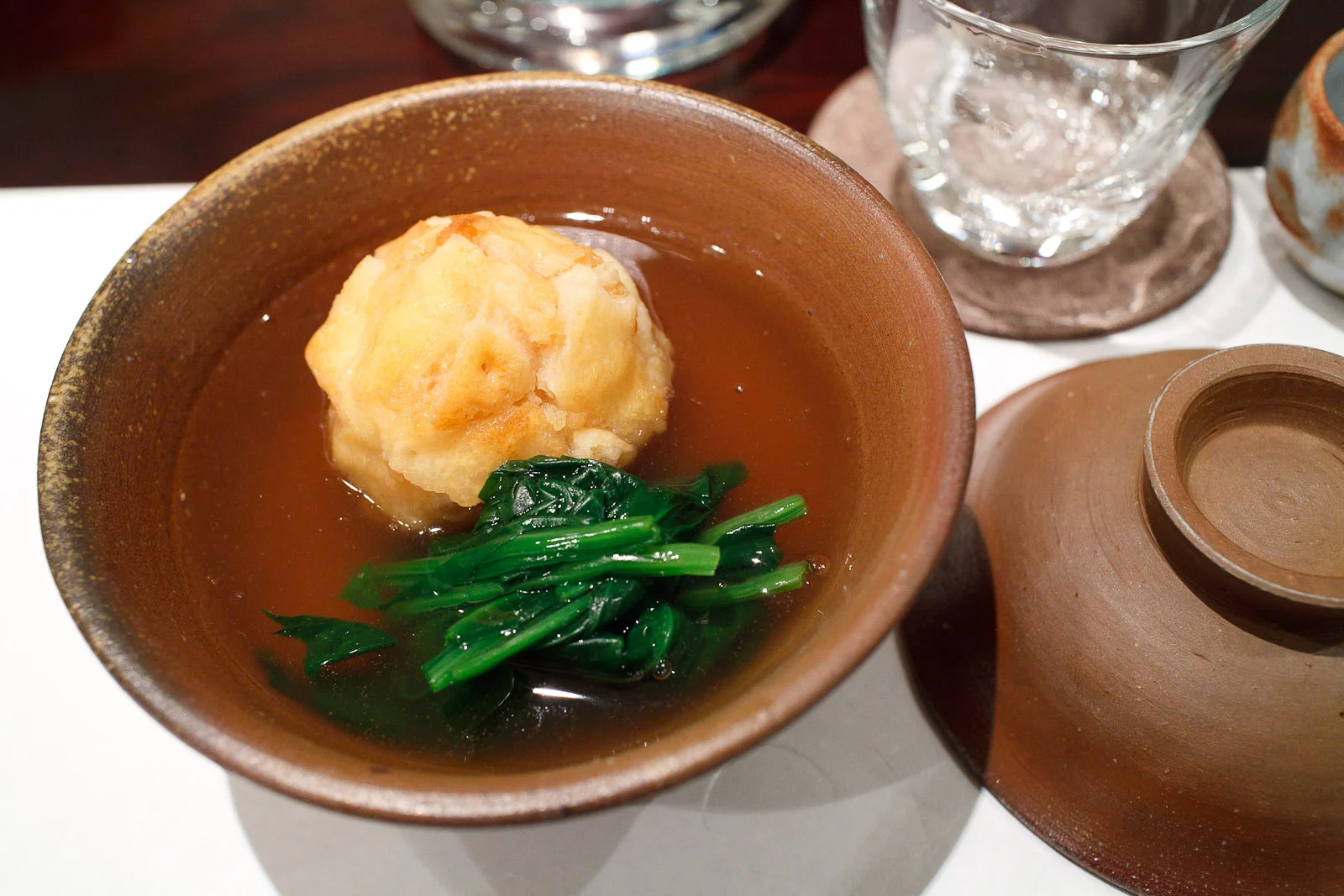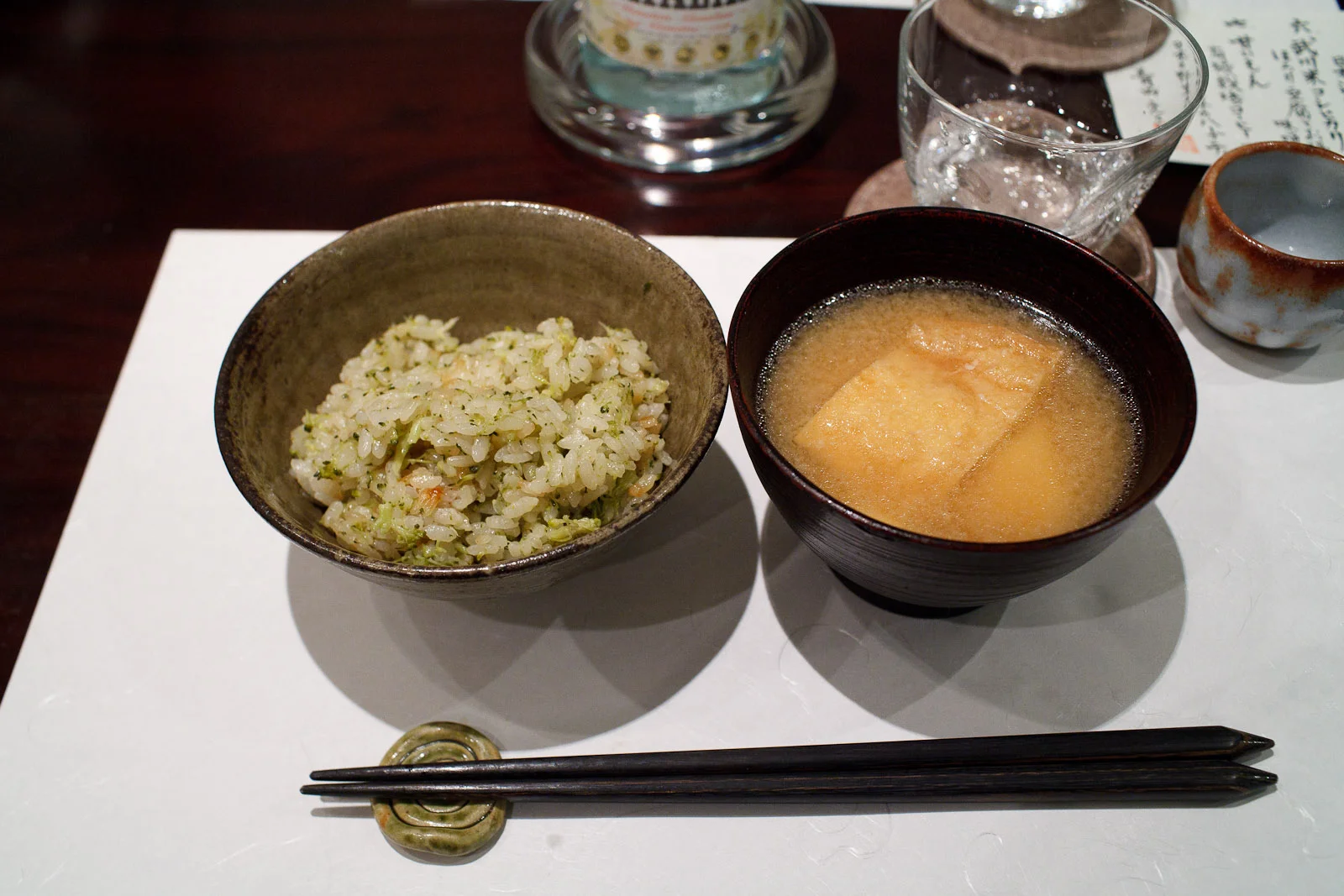Esaki
It's easy to walk down the quiet residential streets of Jingu-mae and miss this restaurant: it's in the basement of an apartment building with no signage. But what Esaki lacks in street-level visibility it makes up for in flavor. It's modern take on traditional kaiseki -- with all locally sourced organic ingredients -- highlights the best of Japanese cuisine yet incorporates a number of modern twists that make for a more interesting, fresh experience. The menu, full of kanji beyond my understanding, proved challenging -- the waitress patiently helped me to decipher the words I didn't know, and even brought paper and pen to take notes. At this 3-starred Michelin restaurant, things suddenly felt a lot more relaxed and comfortable.
Hokkaido scallop with crab risotto, black sesame sauce, and yam chips - The scallop was lightly seared and glowed a translucent gold in the center, a testament to the Japanese understanding that fish tastes best when served raw or barely cooked. The scallop medallions sat atop a bed of crab risotto generously salted and redolent of shellfish flavor. The yam chip provided a textural counterpoint to the dish, but not much else. This hot appetizer was a hit.
Amberjack sashimi - Thick slices of this lean fish was served with strips of Japanese radish, soy sauce, and fresh wasabi. The texture was a bit like yellowtail but firmer and more clean tasting.
Spanish mackerel, green tomato, and radish, with a white sesame and mushroom sauce - The fish once again was just barely cooked with absolutely no signs of dryness. The thick sesame and mushroom sauce coated all the ingredients adding a fine pasty texture with a strong flavor of sesame. The green tomato added a hint of acidity while the white radish added a textural crunch. This was pretty good but the flavor got a little monotonous by the third bite.
Japanese dashi with hamaguri - This was my favorite dish of the night. The dashi broth was almost clear with just the slightest hint of milky white. It acted as a base for the clam that was so soft it nearly fell apart in my mouth. What was so amazing about this dish was its purity -- a single flavor shining through perfectly clear. After I ate the clam the broth kept the memory of that flavor alive in my mouth for awhile afterwards. This was flawless.
Lily root dumpling stuffed with chicken and egg and encrusted in Japanese rice crackers - This was phenomenal. The light meat ball was stuffed with thick chunks of chicken and lily root bound together by the egg. The large chunks of chicken kept the density of the ball down making this really light and fluffy. Almost like an airy Japanese matzah ball. The porous interior was filled with the thickened dashi broth keeping it moist. The outside of the ball was salty with a hint of sweetness. Some parts of the crust were still crispy, much like the portion of a pie inbetween the crust and the wedge.
Broccoli rice and miso soup with soft and firm tofu - The rice was garnished with bits of sauteed broccoli making this taste a little bit like chicken Rice-a-Roni. It actually tasted almost like a bit of chicken broth was added to the rice, even though I'm pretty sure it wasn't. This was really good. The soup was particularly interesting because it had two types of tofu in it -- one deep fried, and the other soft and smooth.
Milk pudding, ginger ice cream, and soybeans - What made this dessert so interesting was its diversity of texture. Silky smooth milk pudding, crunchy ice crystals from the ginger ice cream, chewy soy beans, and powdered sesame. It was also sweet but not cloying, the flavor being dominated by the ginger and soybeans rather than the sweet pudding. Bites alternated between refreshing and rich. This was pretty good.
We finished the meal with a tisane of ten herbs. I was only able to identify the mint, shiso, verbena, and chamomile.
This was a really pleasant meal, especially for 8,500 JPY. The staple flavor of dashi and sharp acidity of pickled vegetables dominate a lot of traditional kaiseki meals making them difficult to repeat every night. Esaki did a really good job balancing traditional flavors with new ones. Here even the rice course -- which is almost always married with a small side of pickled root vegetables -- was deconstructed and the vegetables absent.
Esaki is a restaurant that I could visit frequently. At the end of the meal I felt perfectly sated. It was a meal with a tremendous range of flavors and textures firmly based in traditional Japanese cuisine. In some ways it's similar to Ryugin, minus the fanciness. While dishes were modernized they remained straightforward and simple. No caviar here.
One way to look at this meal might be as an introduction to kaiseki. It hits all the notes of traditional kaiseki without straying too far from more familiar European flavors. I loved this meal and shared it with two people who aren’t as fond of traditional kaiseki flavors as I am, but Esaki's ability to reinvent and modernize this cuisine ensured that we all finished this meal with huge smiles.
















